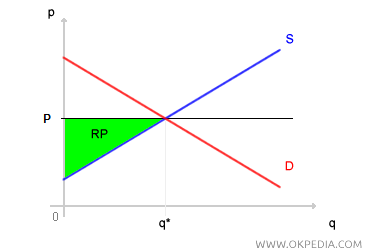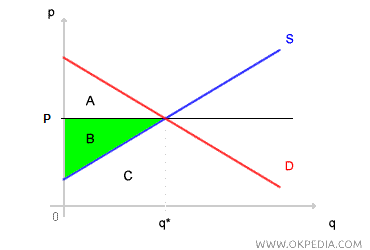Producer Surplus
Producer surplus is the difference between the selling price of a good or service and the marginal cost of producing each unit. It is also referred to as producer rent. The unit producer surplus is calculated as the market price of the good minus the marginal cost of producing that unit:
unit surplus = P - MC
Total producer surplus, in contrast, is the sum of the unit surpluses for all units produced. It reflects the benefit a firm gains from production. For a production quantity of q*, in the Cartesian diagram below, the producer surplus is represented by the area (PS) between the price line (P) and the supply curve (S).

In a competitive market, total producer surplus is equal to the difference between total revenue and total variable costs.
total surplus = total revenue - total variable costs
Since a firm's total revenue equals the sum of profit, fixed costs, and variable costs, producer surplus can be defined as the sum of the firm's profit and fixed costs. Producer surplus (or producer rent) can also be understood through graphical analysis.

In the Cartesian diagram above, area B+C represents the economic revenue the firm earns by selling q* units of the good at the market price p*. Area C shows the minimum revenue needed for the firm to sell q units without incurring losses. The producer surplus is the difference (B+C-C) between the total revenue from sales (B+C) and the minimum revenue required (C), which corresponds to area B in the diagram. Finally, area A represents the consumer surplus.
 Difference Between Producer Surplus and Profit. Producer surplus differs from economic profit because, unlike profit, it does not include fixed costs.
Difference Between Producer Surplus and Profit. Producer surplus differs from economic profit because, unlike profit, it does not include fixed costs.
